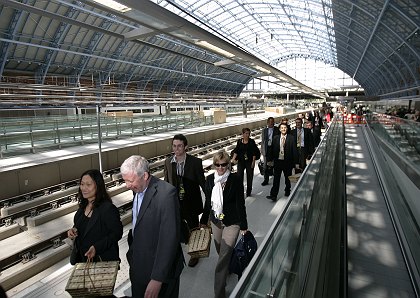Spending money on railroads

Passengers leave an inaugural service Eurostar train, partially seen right, shortly after its arrival at the newly refurbished St. Pancras train station, in central London, Tuesday Sept. 4, 2007. Eurostar set a new record on Tuesday for train travel between Paris and London when an inaugural service completed the journey in just over two hours. The journey was more than 30 minutes faster than the current two hours, 35 minutes time between Paris and London's Waterloo International. That route will close in November when services switch to St. Pancras. (AP Photo/Lefteris Pitarakis)
Amtrak has announced a ridership increase, and on the Northeast Corridor line especially, an increase in the number of riders with choices, see the press release "Annual Amtrak Ridership Sets All-Time Record; Fifth Straight Year of Increases." WMATA announces an increase in ridership, particularly by DC residents. See "D.C. Leads Ridership Surge," subtitled "Biggest Increase Is Found in City," from the Post.
In London, a restored St. Pancras Station has opened to serve as the terminus for the Eurostar trains to Europe. See "London Station Reawakens in Victorian Splendor," from Der Spiegel.
From the article:
The price tag is £5.9 billion ($12.3 billion), Britain's largest rail investment ever. Eurostar, which operates trains from London to Paris and Brussels, says journey times will be cut by an average of 25 minutes.
Eurostar services now switch from Waterloo International to leave St. Pancras on a new 25-mile section of track called High Speed 1. Hurtling 68 miles across Kent to the Channel Tunnel's mouth at Folkestone, the trains will pass through new stations at Stratford and Ebbsfleet at 186 mph.
Not quite the flashing 200mph reached on the French TGV rail network. Or on the benchmark Japanese intercity rail services. But still pretty close and a fillip to British transport pride after years of dreadful rail performance. London to Paris now takes 2 hours, 15 minutes, London to Brussels 1 hour, 51 minutes; a shaving of 25 minutes apiece.
There will be 17 trains each day from St. Pancras to Paris alone. The new link also promises a £10 billion regeneration of the Thames Gateway region and a new rail service for London's Olympic Games in 2012. The engineering achievement -- 30 miles of tunnelling, new track, signalling and station building by London and Continental Railways -- is matched by an £800 million revamp and glass canopy extension for one of London's oldest rail termini, St Pancras Station.
A London landmark since 1868, the station has been completely refurbished and now linked by six Tube lines and seven rail connections.

A Eurostar train on highspeed track from Paris to London arrives at St Pancras International train station for the first time in central London, Tuesday Sept. 4, 2007. The train, having traveled from Paris Gare du Nord on its inaugural journey on High Speed 1, the UK's first high-speed line at speeds of up to 186mph (300kph). St Pancras International will be Eurostar's new central London home from Nov. 2007. (AP Photo/Lefteris Pitarakis)
Now that's investment in infrastructure.
Labels: infrastructure, mobility, railroads, transportation planning



0 Comments:
Post a Comment
<< Home